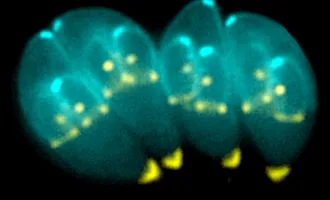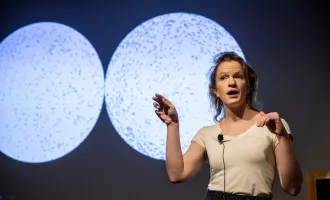Targeting Telomeres, Reusable Rockets
Targeting Tumor Telomeres:
If you break an aglet—the plastic cap on the end of your shoelace—the lace will fray. Then it’ll rip. Soon you won’t be able to tie your shoe properly. Before you know it, the shoe falls off as you’re running frantically down the sidewalk trying to catch a bus. As you watch the bus drive away, you’ll wish you’d kept that aglet intact.
Aglets are to shoelaces as telomeres are to chromosomes. Ah, the memory of the analogy section (rest in peace) on the SAT and GRE.
To avoid losing bits of genetic code at the ends of chromosomes during DNA replication and cell division, cells use the telomerase enzyme and an RNA template to add a repeating pattern of DNA to cap each chromosome: the telomere. These discoveries earned UCSF’s Elizabeth Blackburn (as well as Carol Greider and Jack Szostak) the Nobel Prize in physiology or medicine in 2009.
Telomerase is active during normal development but is largely turned off in adult cells. However, by some estimates, nearly 90 percent of human cancers re-express this enzyme. Turning telomerase back on allows a growing tumor, just like a developing organ, to keep its telomeres and chromosomes intact.
Blocking telomerase, whose activity is almost exclusively limited to cancer cells, is not a new idea. However, using a telomerase inhibitor (e.g. imetelstat sodium) in the absence of any other therapy means that the patient has to wait for his or her cancer cells to continue to divide, shorten their telomeres, and reach a crisis state of DNA damage and growth arrest. That lag in therapeutic efficacy requires the drug to be used for a long period of time, widening the window for developing adverse side effects. Even clinical trials combining telomerase inhibition with chemotherapy have been hampered by these problems.
The groups of Jerry Shay and Woodring Wright at UT Southwestern Medical Center have co-published a novel telomerase therapy in this month’s issue of Cancer Discovery. Instead of blocking telomerase activity directly, as therapies have attempted in the past, these researchers created a small molecule that mimicked the normal RNA template. In cells, it is phosphorylated and then mistaken for the normal template and incorporated into telomeres. This changes the biochemical structure of telomeres instantly, destabilizes their interactions with other proteins and sends DNA damage signals that cause growth arrest and cell death.
6-thio-dG treatment of normal and cancer cells in vitro led to telomere shortening, DNA damage and cell death. 6-thio-dG treatment of mouse xenograft models of human cancer led to both telomere damage and tumor shrinkage, with little to no side effect.
While the authors appear to be ready to take their 6-thio-dG into the clinic, it seems to me that any potential telomere-targeting therapy should first be tested in a fully immunocompetent mouse model. Their mouse study was performed in immunocompromised mice to permit the growth of human cancer cells and would certainly miss any toxicity or impaired function in the absent immune cells. Nonetheless, altogether this study represents a much-needed revival for the field of telomere-based cancer therapies. Just like great musicals that flopped in the ‘80s, therapeutic approaches that failed past clinical trials may be revived to great success.
Sources: Cancer Discovery, EurekAlert!
SpaceX Close to a Reusable Rocket:
On Jan. 10, SpaceX successfully launched its Falcon 9 rocket, sending the Dragon spacecraft to the International Space Station. It also almost succeeded in landing the first stage of Falcon 9, vertically, onto a raft—autonomous spaceport drone ship, I should say—200 miles off the coast of Florida.
With its fifth successful ISS resupply mission (and no failures), SpaceX has shouldered most of the responsibility of sending and returning ISS cargo after the retirement of NASA’s space shuttle. SpaceX is critical (read: awesome) both because it allows the U.S. space program to avoid relying on the Russian space program and because the privatization of parts of the space program drives down costs.
A rocket’s first stage is the lower portion that carries the enormous amount of fuel required to propel the payload into space. Until now, this stage has either crash landed in the ocean or been ripped apart in the air. Controlling the first stage’s descent in a way that would make it recoverable and reusable was considered impossible. Elon Musk—the company’s founder, CEO and CTO—is a true visionary. He takes ideas that seem impossible and turns them into reality.
For the past few years, SpaceX has been practicing launching two practice rockets—Grasshopper and F9R Dev—and landing them vertically right back onto the launch pad. This month’s mission was the first attempt to fully recover the rocket.
“At 14 stories tall and traveling upward of 1,300 meters per second (nearly 1 mile per second), stabilizing the Falcon 9 first stage for re-entry is like trying to balance a rubber broomstick on your hand in the middle of a wind storm,” said Musk in preparation for the mission.
“Close, but no cigar,” he tweeted on Jan 10.
While SpaceX engineers were able to control the rocket’s descent enough to find the spaceport raft floating off the coast of Florida, it came down too hard and was destroyed upon impact. The cause appears to be that the hydraulic fluid used to control the rocket’s fins ran out just before landing.
Musk said he remains confident about the next landing attempt (the rocket will have more hydraulic fluid), which will take place during the launch slated for Thursday, Jan. 29. You can watch the launch on the live webcasts on SpaceX.com and SpaceflightNow.com.
Sources: SpaceX, Slate


